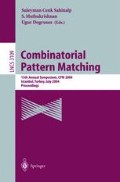Abstract
Selenoproteins contain the 21th amino acid Selenocysteine, which is encoded by the STOP-codon UGA. For its insertion it requires a specific mRNA sequence downstream the UGA-codon that forms a hairpin-like structure (called Sec insertion sequence (SECIS)). Selenoproteins have gained much interest recently since they are very important for human health.
In contrast, very little is known about selenoproteins. For example, there is only one solved crystal structure available. One reason for this is that one is not able to produce enough amount of selenoproteins by using recombinant expression in a system like E.coli. The reason is that the insertion mechanisms are different between E.coli and eukaryotes. Thus, one has to redesign the human/mammalian selenoprotein for the expression in E.coli. In this paper, we introduce an polynomial-time algorithm for solving the computational problem involved in this design, and we present results for known selenoproteins.
Access this chapter
Tax calculation will be finalised at checkout
Purchases are for personal use only
Preview
Unable to display preview. Download preview PDF.
References
Arner, E.S., Sarioglu, H., Lottspeich, F., Holmgren, A., Bock, A.: High-level expression in escherichia coli of selenocysteine-containing rat thioredoxin reductase utilizing gene fusions with engineered bacterial-type SECIS elements and co-expression with the selA, selB and selC genes. Journal of Molecular Biology 292(5), 1003–1116 (1999)
Backofen, R., Narayanaswamy, N.S., Swidan, F.: Protein similarity search under mRNA structural constraints: application to targeted selenocysteine insertion. In Silico Biology 2(3), 275–290 (2002)
Backofen, R., Narayanaswamy, N.S., Swidan, F.: On the complexity of protein similarity search under mrna structure constraints. In: Alt, H., Ferreira, A. (eds.) STACS 2002. LNCS, vol. 2285, pp. 274–286. Springer, Heidelberg (2002)
Bar-Noy, S., Moskovitz, J.: Mouse methionine sulfoxide reductase b: effect of selenocysteine incorporation on its activity and expression of the seleno-containing enzyme in bacterial and mammalian cells. Biochem. Biophys. Res. Commun. 297(4), 956–961 (2002)
Bateman, A., Birney, E., Cerruti, L., Durbin, R., Etwiller, L., Eddy, S.R., Griffiths- Jones, S., Howe, K.L., Marshall, M., Sonnhammer, E.L.: Marshall, and E. L. Sonnhammer. The Pfam protein families database. Nucleic Acids Res. 30(1), 276–280 (2002)
Böck, A., Forchhammer, K., Heider, J., Baron, C.: Heider, and C. Baron. Selenoprotein synthesis: an expansion of the genetic code. Trends Biochem. Sci. 16(12), 463–467 (1991)
Brown, K.M., Arthur, J.R.: Selenium, selenoproteins and human health: a review. Public Health Nutr 4(2B), 593–599 (2001)
Hazebrouck, S., Camoin, L., Faltin, Z., Strosberg, A.D., Eshdat, Y.: Substituting selenocysteine for catalytic cysteine 41 enhances enzymatic activity of plant phospholipid hydroperoxide glutathione peroxidase expressed in escherichia coli. Journal of Biological Chemistry 275(37), 28715–28721 (2000)
Heider, J., Baron, C., Böck, A.: Coding from a distance: dissection of the mRNA determinants required for the incorporation of selenocysteine into protein. EMBO J. 11(10), 3759–3766 (1992)
Hüttenhofer, A., Böck, A.: RNA structures involved in selenoprotein synthesis. In: Simons, R.W., Grunberg-Manago, M. (eds.) RNA Structure and Function, pp. 603–639. Cold Spring Habor Laboratory Press, Cold Spring Habor (1998)
Gregory, V.: Kryukov, Sergi Castellano, Sergey V. Novoselov, Alexey V 300(5624), 1439–1443 (2003)
Liu, Z., Reches, M., Groisman, I., Engelberg-Kulka, H.: The nature of the minimal ’selenocysteine insertion sequence’ (SECIS) in Escherichia coli. Nucleic Acids Research 26(4), 896–902 (1998)
Low, S.C., Berry, M.J.: Knowing when not to stop: selenocysteine incorporation in eukaryotes. Trends in Biochemical Sciences 21(6), 203–208 (1996)
Sandalova, T., Zhong, L., Lindqvist, Y., Holmgren, A., Schneider, G.: Threedimensional structure of a mammalian thioredoxin reductase: implications for mechanism and evolution of a selenocysteine-dependent enzyme. Proc. Natl. Acad. Sci. USA 98(17), 9533–9538 (2001)
Sawers, G., Heider, J., Zehelein, E., Böck, A.: Expression and operon structure of the sel genes of escherichia coli and identification of a third selenium-containing formate dehydrogenase isoenzyme. J. Bacteriol 173(16), 4983–4993 (1991)
Tujebajeva, R.M., Harney, J.W., Berry, M.J.: Selenoprotein P expression, purification, and immunochemical characterization. Journal of Biological Chemistry 275(9), 6288–6294 (2000)
Zinoni, F., Heider, J., Böck, A.: Features of the formate dehydrogenase mRNA necessary for decoding of the UGA codon as selenocysteine. Proc. Natl. Acad. Sci.USA 87(12), 4660–4664 (1990)
Author information
Authors and Affiliations
Editor information
Editors and Affiliations
Rights and permissions
Copyright information
© 2004 Springer-Verlag Berlin Heidelberg
About this paper
Cite this paper
Backofen, R., Busch, A. (2004). Computational Design of New and Recombinant Selenoproteins. In: Sahinalp, S.C., Muthukrishnan, S., Dogrusoz, U. (eds) Combinatorial Pattern Matching. CPM 2004. Lecture Notes in Computer Science, vol 3109. Springer, Berlin, Heidelberg. https://doi.org/10.1007/978-3-540-27801-6_20
Download citation
DOI: https://doi.org/10.1007/978-3-540-27801-6_20
Publisher Name: Springer, Berlin, Heidelberg
Print ISBN: 978-3-540-22341-2
Online ISBN: 978-3-540-27801-6
eBook Packages: Springer Book Archive

